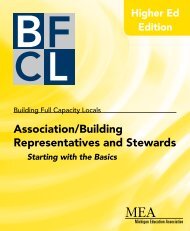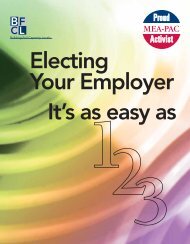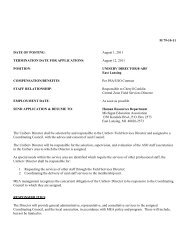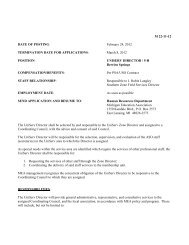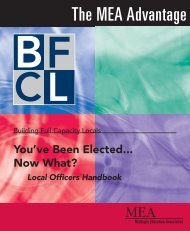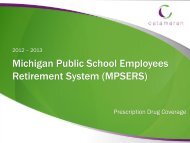Extended School Year Services in Michigan - Michigan Education ...
Extended School Year Services in Michigan - Michigan Education ...
Extended School Year Services in Michigan - Michigan Education ...
You also want an ePaper? Increase the reach of your titles
YUMPU automatically turns print PDFs into web optimized ePapers that Google loves.
<strong>Extended</strong> <strong>School</strong> <strong>Year</strong> <strong>Services</strong> <strong>in</strong><br />
<strong>Michigan</strong>: Standards and Guidance for<br />
Educators, Service Providers, and<br />
Families<br />
October 24, 2007
Table of Contents<br />
Standards for <strong>Extended</strong> <strong>School</strong> <strong>Year</strong> <strong>Services</strong> In <strong>Michigan</strong> ...................................... 3<br />
Purpose .......................................................................................................... 4<br />
Section 1: Legal Framework ............................................................................. 4<br />
Section 2: Def<strong>in</strong><strong>in</strong>g <strong>Extended</strong> <strong>School</strong> <strong>Year</strong> <strong>Services</strong> <strong>in</strong> <strong>Michigan</strong>.............................. 5<br />
Section 3: <strong>Extended</strong> <strong>School</strong> <strong>Year</strong> Service Provision............................................... 7<br />
Section 4: <strong>Extended</strong> <strong>School</strong> <strong>Year</strong> and Summer <strong>School</strong> .......................................... 9<br />
Section 5: Frequently Asked Questions About <strong>Extended</strong> <strong>School</strong> <strong>Year</strong>....................... 11<br />
Appendix A: Free Appropriate Public <strong>Education</strong> Federal Regulations........................ 12<br />
Appendix B: Worksheet Example for Families and <strong>School</strong>s to Aid <strong>in</strong> the<br />
Discussion of <strong>Extended</strong> <strong>School</strong> <strong>Year</strong> Service Considerations ................................. 13<br />
Appendix C: Prototype Model Form to Document <strong>Extended</strong> <strong>School</strong> <strong>Year</strong><br />
Consideration................................................................................................ 15<br />
2<br />
Draft: October 24, 2007
Standards for <strong>Extended</strong> <strong>School</strong> <strong>Year</strong><br />
<strong>Services</strong> <strong>in</strong> <strong>Michigan</strong><br />
The need for extended school year (ESY) services must be considered for every<br />
student at his/her Individualized <strong>Education</strong> Program Team (IEP Team) meet<strong>in</strong>g.<br />
ESY services must be provided if the IEP Team determ<strong>in</strong>es that such services are necessary<br />
to the provision of a free appropriate public education to the student.<br />
The IEP Team’s consideration for ESY services must address the follow<strong>in</strong>g<br />
standards:<br />
Regression/Recoupment:<br />
• The student will substantially regress <strong>in</strong> critical skills as a result of an <strong>in</strong>terruption <strong>in</strong><br />
<strong>in</strong>struction.<br />
• The student will likely require significant time to recoup lost skills.<br />
Nature and/or Severity of Disability<br />
• The student requires more consistent and highly-structured programm<strong>in</strong>g<br />
techniques due to the severity of the disability.<br />
• The student will suffer significant loss of skills or behavior <strong>in</strong> areas deemed to be<br />
crucial to reach<strong>in</strong>g the ultimate goal of <strong>in</strong>dependence.<br />
Critical Stages and Areas of Learn<strong>in</strong>g<br />
• The student’s degree of progress <strong>in</strong> any of the critical life skills identified by the<br />
<strong>in</strong>dividualized education program (<strong>in</strong>clud<strong>in</strong>g, but not limited to, self-sufficiency,<br />
<strong>in</strong>dependence from caretakers, development of motor and/or communication skills,<br />
etc.) will be jeopardized by an <strong>in</strong>terruption <strong>in</strong> <strong>in</strong>struction.<br />
Please refer to “Guidance for <strong>Michigan</strong> <strong>Extended</strong> <strong>School</strong> <strong>Year</strong> <strong>Services</strong>” for more details on<br />
procedures and considerations.<br />
3<br />
Draft: October 24, 2007
Guidance for <strong>Michigan</strong> <strong>Extended</strong> <strong>School</strong> <strong>Year</strong> <strong>Services</strong><br />
Purpose<br />
The purpose of this document is to provide <strong>in</strong>formation and assistance for parents,<br />
educators, adm<strong>in</strong>istrators, and service providers regard<strong>in</strong>g the consideration for extended<br />
school year (ESY) services <strong>in</strong> <strong>Michigan</strong>. This document def<strong>in</strong>es ESY services accord<strong>in</strong>g to<br />
regulations implement<strong>in</strong>g the Individuals with Disabilities <strong>Education</strong> Act (IDEA) of 2006,<br />
outl<strong>in</strong>es a brief legal history of, and justification for, ESY services <strong>in</strong> both federal and state<br />
contexts, provides an explanation of processes <strong>in</strong>volved <strong>in</strong> determ<strong>in</strong><strong>in</strong>g ESY eligibility and<br />
implementation, and answers frequently asked questions.<br />
Section 1: Legal Framework<br />
Provisions for ESY services were first established by regulations implement<strong>in</strong>g the IDEA.<br />
Prior to this, the basis for <strong>in</strong>terpretation of ESY requirements was drawn from case law. The<br />
1999 regulations implement<strong>in</strong>g the IDEA did not create legal standards for ESY services, but<br />
brought together well-established case law <strong>in</strong> this area. The regulations implement<strong>in</strong>g the<br />
reauthorized IDEA 2004 at §300.106 have upheld the requirements as implemented <strong>in</strong><br />
1999.<br />
Federal Regulations on <strong>Extended</strong> <strong>School</strong> <strong>Year</strong> <strong>Services</strong> (2006)<br />
A. General.<br />
1. Each school must ensure that ESY services are available as necessary to provide a free<br />
appropriate public education (FAPE).<br />
2. ESY services must be provided only if a child’s Individualized <strong>Education</strong> Program Team<br />
(IEPT) determ<strong>in</strong>es, on an <strong>in</strong>dividual basis, that the services are necessary for the<br />
provision of a FAPE to the student.<br />
3. In implement<strong>in</strong>g the requirements of ESY services, a school may not:<br />
a. limit ESY services to particular categories of disability; or<br />
b. unilaterally limit the type, amount, or duration of those services.<br />
B. Def<strong>in</strong>ition.<br />
As used <strong>in</strong> this section, the term ESY services means special education and related services<br />
that:<br />
1. Are provided to a child with a disability:<br />
a. beyond the normal school year of the school;<br />
b. <strong>in</strong> accordance with the child’s IEP; and<br />
c. at no cost to the parent of the student.<br />
2. Meet the standards of the state education agency. (§300.106)<br />
4<br />
Draft: October 24, 2007
Section 2: Def<strong>in</strong><strong>in</strong>g <strong>Extended</strong> <strong>School</strong> <strong>Year</strong> <strong>Services</strong> <strong>in</strong> <strong>Michigan</strong><br />
What are ESY services?<br />
ESY refers to special education and/or related services provided beyond the normal school<br />
year for the purpose of provid<strong>in</strong>g a FAPE to a student with a disability. The purpose of ESY is<br />
different from the purpose of enrichment programs, summer school programs offered to all<br />
students, or compensatory education programs, and are not simply an extension of the<br />
regular school year. ESY services are offered at no cost to parents and will vary <strong>in</strong> type,<br />
location, and length of time, depend<strong>in</strong>g on the <strong>in</strong>dividual needs of the student. The purpose<br />
of ESY services is to ma<strong>in</strong>ta<strong>in</strong> skills, not to develop new ones.<br />
ESY services are NOT:<br />
● for teach<strong>in</strong>g new skills;<br />
● based on the category of student’s disability;<br />
● mandated for all students with disabilities;<br />
● required 12-month programs;<br />
● child-care services;<br />
● necessarily a cont<strong>in</strong>uation of the total IEP provided to a student with a disability dur<strong>in</strong>g<br />
the regular school year;<br />
● required to be provided all day or every day;<br />
● an automatic provision from year-to-year;<br />
● required to be provided <strong>in</strong> a traditional classroom sett<strong>in</strong>g;<br />
● a service to be provided to maximize each student’s potential;<br />
● for credit recovery; and<br />
● a replacement for lack of attendance.<br />
Why does <strong>Michigan</strong> have ESY services?<br />
The IDEA of 2004 assigns educators the responsibility of develop<strong>in</strong>g and deliver<strong>in</strong>g a FAPE<br />
to students with disabilities. The IDEA def<strong>in</strong>es FAPE as special education and related<br />
services that are provided at public expense <strong>in</strong> conformity with an <strong>in</strong>dividualized education<br />
program (IEP).<br />
Essential to the provision of a FAPE is the IEP Team’s determ<strong>in</strong>ation of what services are<br />
appropriate to meet the dist<strong>in</strong>ctive educational needs of each student <strong>in</strong> a suitable<br />
environment. The IEP process ensures that students with disabilities receive a FAPE.<br />
Some students with disabilities may not receive a FAPE unless they participate <strong>in</strong> programs<br />
or services dur<strong>in</strong>g time periods when other students, whether they have a disability or not,<br />
normally would not be served. For such students, restrict<strong>in</strong>g services to a standard number<br />
of school days does not allow the development of an educational program that is truly<br />
<strong>in</strong>dividualized. Consequently, some students may require ESY services <strong>in</strong> order to receive a<br />
FAPE.<br />
Who is eligible for ESY services?<br />
Any student with an IEP is eligible for the consideration of ESY services if ESY is essential to<br />
provide a FAPE. Each student has his or her own <strong>in</strong>dividual educational needs. Therefore,<br />
ESY services will accomplish different purposes for different students. Some students may<br />
suffer losses of social, behavioral, communication, academic, self-sufficiency, or other skills<br />
5<br />
Draft: October 24, 2007
dur<strong>in</strong>g <strong>in</strong>terruptions <strong>in</strong> academic year <strong>in</strong>struction. This is particularly relevant dur<strong>in</strong>g long<br />
breaks, such as summer vacation. These losses may be so significant that they can actually<br />
jeopardize progress obta<strong>in</strong>ed dur<strong>in</strong>g the regular academic year. When the school year<br />
resumes, it is possible that unreasonable amounts of time are needed to recoup lost skills.<br />
Case law has referred to these <strong>in</strong>stances with terms such as regression and recoupment.<br />
Factors to Consider to Determ<strong>in</strong>e Eligibility for ESY<br />
● Regression/Recoupment. Loss of critical knowledge and/or acquired skills <strong>in</strong>cluded <strong>in</strong><br />
the objectives of the student’s IEP, result<strong>in</strong>g from a scheduled break <strong>in</strong> <strong>in</strong>struction.<br />
Regression can be an <strong>in</strong>dication of a student’s <strong>in</strong>ability to ma<strong>in</strong>ta<strong>in</strong> performance or to<br />
generalize acquired skills to new sett<strong>in</strong>gs outside of the <strong>in</strong>structional environment.<br />
Recoupment is the process of rega<strong>in</strong><strong>in</strong>g skills, through review and re-teach<strong>in</strong>g, follow<strong>in</strong>g<br />
a scheduled break <strong>in</strong> <strong>in</strong>struction. Both of these conditions should be evaluated by the IEP<br />
Team <strong>in</strong> determ<strong>in</strong><strong>in</strong>g eligibility for ESY services.<br />
It is important to note that the IDEA 2004 and various court cases do not address the<br />
extent of regression or recoupment necessary to qualify for ESY services. It is, therefore,<br />
the decision of the IEP Team made on an <strong>in</strong>dividualized basis. In addition, the<br />
determ<strong>in</strong>ation of eligibility for ESY services can be based on an assessment of the<br />
likelihood of regression or other factors that can h<strong>in</strong>der progress on a student’s IEP<br />
goals.<br />
A student cannot be required to fail or demonstrate a lack of progress for an entire year<br />
simply to prove the need for ESY services. If no empirical data are available on regression,<br />
the need may be shown by expert op<strong>in</strong>ion, parent <strong>in</strong>put, or prospective criteria established<br />
by the IEP Team.<br />
● Nature and severity of the student’s disability. If a student requires more consistent<br />
and highly-structured programm<strong>in</strong>g techniques due to the severity of the disability, the<br />
student may be more vulnerable to regression when the school program is <strong>in</strong>terrupted. A<br />
severely disabled student may revert to lower function<strong>in</strong>g levels or exhibit more behaviors<br />
which <strong>in</strong>terfere with learn<strong>in</strong>g after a long break <strong>in</strong> programm<strong>in</strong>g. If the nature or severity<br />
of a student’s disability is such, then the student may be eligible for ESY services.<br />
● Critical Stages and Areas of Learn<strong>in</strong>g. If a student’s degree of progress <strong>in</strong> any of the<br />
critical life skills identified by the IEP (<strong>in</strong>clud<strong>in</strong>g, but not limited to self-sufficiency,<br />
<strong>in</strong>dependence from caretakers, development of motor and/or communication skills, etc.) is<br />
potentially jeopardized by an <strong>in</strong>terruption <strong>in</strong> <strong>in</strong>struction, the student may be eligible for<br />
ESY services. Considerations may <strong>in</strong>clude:<br />
• Breakthrough opportunities. If a student is at a critical po<strong>in</strong>t for acquir<strong>in</strong>g one or<br />
more skills, and a break <strong>in</strong> <strong>in</strong>struction may h<strong>in</strong>der the progress towards this skill,<br />
ESY services may be provided.<br />
• Loss of access to on-the-job tra<strong>in</strong><strong>in</strong>g or productive employment as a result<br />
of regression <strong>in</strong> skills. If an <strong>in</strong>terruption <strong>in</strong> <strong>in</strong>struction will lead to a regression <strong>in</strong><br />
skills relat<strong>in</strong>g to vocational tra<strong>in</strong><strong>in</strong>g, ESY services may be provided.<br />
• Interfer<strong>in</strong>g behaviors. If the IEP Team determ<strong>in</strong>es that an <strong>in</strong>terruption <strong>in</strong><br />
<strong>in</strong>struction will result <strong>in</strong> the loss of progress on <strong>in</strong>terfer<strong>in</strong>g behaviors such as<br />
6<br />
Draft: October 24, 2007
stereotypic, ritualistic, aggressive, or <strong>in</strong>jurious behavior(s) that affect a student’s<br />
ability to accomplish IEP goals, the student may be eligible for ESY services.<br />
• IEP goals. ESY services are not granted solely on the basis of a student not<br />
meet<strong>in</strong>g one or more of the IEP goals. However, if a student has not made adequate<br />
progress on his/her planned IEP goals, he/she may be eligible for ESY services. It is<br />
important to note that noth<strong>in</strong>g <strong>in</strong> federal law or the correspond<strong>in</strong>g regulations<br />
requires students with disabilities who do not meet their IEP goals to participate <strong>in</strong><br />
ESY.<br />
Aga<strong>in</strong>, the purpose of all ESY services is not to develop new skills.<br />
Section 3: <strong>Extended</strong> <strong>School</strong> <strong>Year</strong> Service Provision<br />
Who is responsible for the provision of ESY services <strong>in</strong> <strong>Michigan</strong>?<br />
It is the obligation of each school to ensure that students with disabilities who require ESY<br />
services <strong>in</strong> order to receive a FAPE have the necessary services available to them. The right<br />
of an <strong>in</strong>dividual student with a disability to ESY services is based on that student’s<br />
entitlement to a FAPE.<br />
Who determ<strong>in</strong>es the need for ESY services?<br />
The need for ESY services is determ<strong>in</strong>ed on an <strong>in</strong>dividualized basis by the student’s IEP<br />
Team. The student’s IEP Team is a group of <strong>in</strong>dividuals composed of: the student’s parents,<br />
the student, if appropriate, general education teacher(s), special education and related<br />
service providers, an adm<strong>in</strong>istrator or school representative, <strong>in</strong>dividual(s) who can <strong>in</strong>terpret<br />
the <strong>in</strong>structional implications of evaluation results, and others as appropriate. Each member<br />
of the IEP Team br<strong>in</strong>gs important <strong>in</strong>formation about the student’s <strong>in</strong>dividual needs and<br />
his/her academic, social, and behavioral progress.<br />
How is the need for ESY services measured?<br />
Determ<strong>in</strong>ation of a student’s need for ESY services is not based on a formula. Formulas do<br />
not ensure that each student with a disability has the appropriate educational plann<strong>in</strong>g to<br />
meet his/her unique needs. Case law supports the conclusion that the determ<strong>in</strong>ation of need<br />
for ESY services cannot be based on a policy that prohibits full consideration of the needs<br />
for each student with a disability.<br />
The IEP Team needs a variety of <strong>in</strong>formation to determ<strong>in</strong>e a student’s need for ESY<br />
services. This <strong>in</strong>formation is collected through an ongo<strong>in</strong>g assessment of the student’s<br />
progress towards IEP goals. Information can be gathered by a range of <strong>in</strong>formal and formal<br />
methods. The follow<strong>in</strong>g list <strong>in</strong>cludes some approaches to measur<strong>in</strong>g a student’s need for<br />
ESY services. Please note that this list is not exhaustive of all possibilities:<br />
● daily academic or behavioral performance records;<br />
● criterion-referenced and norm-referenced test data;<br />
● anecdotal records from <strong>in</strong>formation collected throughout the year;<br />
● behavioral checklists;<br />
● student work samples;<br />
● IEP progress reports;<br />
7<br />
Draft: October 24, 2007
● expert op<strong>in</strong>ion;<br />
● parent <strong>in</strong>put;<br />
● therapy logs;<br />
● po<strong>in</strong>t sheets;<br />
● frequency charts;<br />
● the student’s prior experience with regression/recoupment; and<br />
● other predictive <strong>in</strong>formation.<br />
The IEP Team should strive to collect <strong>in</strong>formation about the student at basel<strong>in</strong>e,<br />
<strong>in</strong>termediate, and end-po<strong>in</strong>t <strong>in</strong>tervals of the IEP. The series of measurements may be:<br />
1. At the end of <strong>in</strong>struction (i.e., the end of the current school year);<br />
2. At the beg<strong>in</strong>n<strong>in</strong>g of the subsequent <strong>in</strong>struction (i.e., the beg<strong>in</strong>n<strong>in</strong>g of the next school<br />
year); and<br />
3. At the time of recoupment (i.e., the date of rega<strong>in</strong><strong>in</strong>g skills that have been atta<strong>in</strong>ed by<br />
the end of the previous school year).<br />
When review<strong>in</strong>g a student’s IEP, the IEP Team must consider the student’s progress with<br />
respect to ESY services. As mentioned above, these circumstances <strong>in</strong>clude regression and<br />
recoupment, breakthrough opportunities, <strong>in</strong>completion of IEP goals, critical life-skill areas,<br />
loss of access to on-the-job tra<strong>in</strong><strong>in</strong>g, and/or <strong>in</strong>terfer<strong>in</strong>g behaviors.<br />
Should new goals be developed for ESY services?<br />
No. ESY services are <strong>in</strong>tended to ma<strong>in</strong>ta<strong>in</strong> previously-learned skills as identified <strong>in</strong> the<br />
current IEP. The purpose of ESY services is not to teach new skills. New goals should not<br />
be added to a student’s IEP for the implementation of ESY services.<br />
When should the IEP Team meet to determ<strong>in</strong>e ESY services?<br />
The IEP Team is obligated to consider the need for ESY services at the annual IEP meet<strong>in</strong>g.<br />
While the student’s IEP must be renewed every calendar year, there is no deadl<strong>in</strong>e for<br />
proposed ESY services with<strong>in</strong> the IEP. In other words, the IEP Team may decide to add or<br />
subtract the need for various ESY services throughout the year, mak<strong>in</strong>g changes to the IEP<br />
as necessary.<br />
In the event that the need for ESY services and/or the characteristics of those services are<br />
not known at the time of the annual IEP meet<strong>in</strong>g, the IEP Team can identify the date it will<br />
reconvene to determ<strong>in</strong>e the need and services to be provided. The IEP Team may also plan<br />
what data should be gathered to assist <strong>in</strong> mak<strong>in</strong>g later determ<strong>in</strong>ations. An addendum<br />
document<strong>in</strong>g any changes may be completed and attached to the current IEP.<br />
Although there is no timel<strong>in</strong>e for the IEP Team’s consideration of ESY services, the IDEA<br />
regulations specify that “public agencies are expected to ensure that these determ<strong>in</strong>ations<br />
are made <strong>in</strong> a timely manner so that students with disabilities who require ESY services <strong>in</strong><br />
order to receive FAPE can receive those necessary services.” [Federal Register, Vol. 64, No.<br />
48, 1999, pg. 12576]<br />
8<br />
Draft: October 24, 2007
Does the receipt of ESY services one summer ensure such services <strong>in</strong> subsequent<br />
summers?<br />
No. A student’s <strong>in</strong>volvement <strong>in</strong> ESY services one year does not automatically guarantee ESY<br />
services <strong>in</strong> the follow<strong>in</strong>g year(s). Similarly, if no ESY services were provided <strong>in</strong> a prior year,<br />
it does not follow that ESY services are not needed <strong>in</strong> the current year. The decision is made<br />
on an annual basis.<br />
Where are ESY services provided?<br />
As with any IEP, the needs of the student determ<strong>in</strong>e the services. Individualized ESY<br />
services can be provided <strong>in</strong> a traditional classroom sett<strong>in</strong>g; however, the location and<br />
nature of service delivery can vary with the needs of the student. Other acceptable service<br />
delivery options can <strong>in</strong>clude, but are not limited to:<br />
● a cooperative program with another school district;<br />
● a cooperative program with another community agency; and<br />
● other learn<strong>in</strong>g environments.<br />
What k<strong>in</strong>ds of services can ESY provide?<br />
The follow<strong>in</strong>g list <strong>in</strong>cludes some services which may be acceptable for the provision of ESY.<br />
It is not an exhaustive list of all possible services.<br />
● Daily <strong>in</strong>struction <strong>in</strong> specific IEP goal areas.<br />
● Small group <strong>in</strong>struction.<br />
● One or more related services(s) at a community recreation program.<br />
● Consultation with a job coach.<br />
● Intensive short-term <strong>in</strong>struction at various po<strong>in</strong>ts <strong>in</strong> the summer months to prevent<br />
regression.<br />
● A week of <strong>in</strong>tensive review just prior to the beg<strong>in</strong>n<strong>in</strong>g of the school year.<br />
Section 4. <strong>Extended</strong> <strong>School</strong> <strong>Year</strong> and Summer <strong>School</strong><br />
What is the difference between ESY and summer school?<br />
The follow<strong>in</strong>g table compares summer school with ESY services:<br />
9<br />
Draft: October 24, 2007
SUMMER SCHOOL<br />
Not Required on an IEP<br />
Def<strong>in</strong>ition: An optional or permissive<br />
program provided beyond the regular<br />
school year. A school may elect<br />
whether or not to operate summer classes.<br />
Purpose: Teach<strong>in</strong>g new content or<br />
enrichment and/or offer<strong>in</strong>g recreational<br />
or academic opportunities not<br />
present dur<strong>in</strong>g the regular school year.<br />
Students with and without<br />
disabilities benefit from additional<br />
educational opportunities.<br />
Source: Copenhaver, et. al, Mounta<strong>in</strong> Pla<strong>in</strong>s Regional Resource Center, 2004<br />
10<br />
EXTENDED SCHOOL YEAR SERVICES<br />
Required on an IEP<br />
Def<strong>in</strong>ition: <strong>Services</strong> required by<br />
the IDEA 2004 are to be provided<br />
beyond the traditional school year<br />
for any student with a disability<br />
who needs special education<br />
services and/or related services <strong>in</strong><br />
order to receive a FAPE.<br />
Purpose: Ensur<strong>in</strong>g a student’s<br />
mean<strong>in</strong>gful progress dur<strong>in</strong>g the regular<br />
school year (FAPE) by ma<strong>in</strong>ta<strong>in</strong><strong>in</strong>g<br />
learned skills and prevent<strong>in</strong>g loss of<br />
critical skills. If services are not<br />
provided, students’ skills are<br />
temporarily or permanently lost,<br />
jeopardiz<strong>in</strong>g progress. ESY services<br />
are not provided for the purpose of<br />
help<strong>in</strong>g students with disabilities<br />
advance <strong>in</strong> relation to their peers.<br />
Cost: Free or on a fee basis Cost: Free to parents<br />
Duration: Typically operated on a set<br />
schedule for a number of weeks dur<strong>in</strong>g<br />
the summer for all those who participate.<br />
Location: General education sett<strong>in</strong>g;<br />
based on needs and <strong>in</strong>terests of all<br />
students.<br />
Eligibility: A student’s participation does<br />
not depend on an IEP Team determ<strong>in</strong>ation<br />
of need.<br />
Duration: Schedule, sett<strong>in</strong>g, and<br />
extent of services designed to<br />
meet the <strong>in</strong>dividual needs of a<br />
student <strong>in</strong> order to assure a FAPE.<br />
The amount and duration of<br />
services cannot be determ<strong>in</strong>ed<br />
arbitrarily by a school’s summer<br />
school schedule.<br />
Location: Varies depend<strong>in</strong>g upon<br />
each student; the IEP has more<br />
flexibility regard<strong>in</strong>g location of<br />
services.<br />
Eligibility: IEP Team determ<strong>in</strong>es<br />
the need and extent of services to<br />
meet the unique needs of the<br />
student.<br />
Draft: October 24, 2007
Can a student’s ESY services be provided <strong>in</strong> a school’s optional summer school<br />
program?<br />
Yes. The summer school sett<strong>in</strong>g can offer mean<strong>in</strong>gful opportunities for a student, as well as<br />
provide frequent practice for the ma<strong>in</strong>tenance of skills. However, ESY services must be<br />
tailored to the unique needs of each student and cannot be based solely on the availability<br />
of services dur<strong>in</strong>g the summer. The IEP should provide detailed justification of how a<br />
summer school program would address the student’s unique educational needs.<br />
It is recommended that special education personnel collaborate with summer school staff,<br />
<strong>in</strong>form<strong>in</strong>g them of appropriate modifications and accommodations based on the student’s<br />
needs. Under Section 504 of the Rehabilitation Act of 1973, a school cannot discrim<strong>in</strong>ate<br />
aga<strong>in</strong>st a student with a disability <strong>in</strong> any program and/or activity offered by that school.<br />
Section 5. Frequently Asked Questions about <strong>Extended</strong> <strong>School</strong> <strong>Year</strong><br />
Can students with disabilities who have been placed by their parents <strong>in</strong> private<br />
schools be considered for ESY services?<br />
Yes. Determ<strong>in</strong>ations regard<strong>in</strong>g services to be provided, <strong>in</strong>clud<strong>in</strong>g types and amounts of<br />
services, and which students will be served, are made by a consultation between<br />
representatives of public agencies and representatives of students enrolled by their parents<br />
<strong>in</strong> private schools.<br />
How does the least restrictive environment (LRE) relate to ESY services?<br />
The requirements for placement <strong>in</strong> the LRE dur<strong>in</strong>g the academic year apply to ESY services.<br />
However, a school is not required to create new programs as a means of provid<strong>in</strong>g ESY<br />
services to students with disabilities <strong>in</strong> <strong>in</strong>tegrated sett<strong>in</strong>gs if the school does not provide<br />
services at that time for its students without disabilities.<br />
Similarly, a school is not prohibited from provid<strong>in</strong>g ESY services to a student with a<br />
disability <strong>in</strong> a non-educational sett<strong>in</strong>g if the student’s IEP Team determ<strong>in</strong>es that the student<br />
could receive necessary ESY services <strong>in</strong> that sett<strong>in</strong>g. The IEP Team should consider a<br />
flexible service model that takes the <strong>in</strong>dividualized needs of the student <strong>in</strong>to account.<br />
Are all students with disabilities required to have ESY services?<br />
No. A student and/or his/her guardian(s) have the right to refuse ESY services <strong>in</strong> the event<br />
that they are offered. Likewise, a student and/or his/her guardian(s) have the right to<br />
appeal the decision of the IEP Team <strong>in</strong> the event that ESY services are not offered.<br />
11<br />
Draft: October 24, 2007
Appendix A: Free Appropriate Public <strong>Education</strong> Federal Regulations<br />
§ 300.17 Free appropriate public education.<br />
Free appropriate public education or FAPE means special education and<br />
related services that—<br />
(a) Are provided at public expense, under public supervision and direction,<br />
and without charge;<br />
(b) Meet the standards of the SEA, <strong>in</strong>clud<strong>in</strong>g the requirements of this part;<br />
(c) Include an appropriate preschool, elementary school, or secondary school<br />
education <strong>in</strong> the State <strong>in</strong>volved; and<br />
(d) Are provided <strong>in</strong> conformity with an <strong>in</strong>dividualized education program (IEP)<br />
that meets the requirements of §§ 300.320 through 300.324.<br />
FAPE Requirements<br />
§ 300.101 Free appropriate public education (FAPE).<br />
(a) General. A free appropriate public education must be available to all<br />
children resid<strong>in</strong>g <strong>in</strong> the State between the ages of 3 and 21, <strong>in</strong>clusive, <strong>in</strong>clud<strong>in</strong>g<br />
children with disabilities who have been suspended or expelled from school, as<br />
provided for <strong>in</strong> § 300.530(d).<br />
(b) FAPE for children beg<strong>in</strong>n<strong>in</strong>g at age 3.<br />
(1) Each State must ensure that—<br />
(i) The obligation to make FAPE available to each eligible child resid<strong>in</strong>g <strong>in</strong> the<br />
State beg<strong>in</strong>s no later than the child’s third birthday; and<br />
(ii) An IEP or an IFSP is <strong>in</strong> effect for the child by that date, <strong>in</strong> accordance with<br />
§ 300.323(b).<br />
(2) If a child’s third birthday occurs dur<strong>in</strong>g the summer, the child’s IEP Team<br />
shall determ<strong>in</strong>e the date when services under the IEP or Individualized Family<br />
Service Plan (IFSP) will beg<strong>in</strong>.<br />
(c) Children advanc<strong>in</strong>g from grade to grade.<br />
(1) Each State must ensure that FAPE is available to any <strong>in</strong>dividual child with a<br />
disability who needs special education and related services, even though the child<br />
has not failed or been reta<strong>in</strong>ed <strong>in</strong> a course or grade, and is advanc<strong>in</strong>g from grade<br />
to grade.<br />
(2) The determ<strong>in</strong>ation that a child described <strong>in</strong> paragraph (a) of this section is<br />
eligible under this part, must be made on an <strong>in</strong>dividual basis by the group<br />
responsible with<strong>in</strong> the child’s LEA for mak<strong>in</strong>g eligibility determ<strong>in</strong>ations.<br />
12<br />
Draft: October 24, 2007
Appendix B: Worksheet Example for Families and <strong>School</strong>s to Aid <strong>in</strong> the Discussion<br />
of <strong>Extended</strong> <strong>School</strong> <strong>Year</strong> Service Considerations<br />
Instructions: Below are areas of possible discussion po<strong>in</strong>ts. Attach support<strong>in</strong>g<br />
documentation for any areas checked.<br />
Regression and Recoupment<br />
□ With an <strong>in</strong>terruption <strong>in</strong> <strong>in</strong>struction, the student is likely to lose critical skills or fail to<br />
recover these skills with<strong>in</strong> a reasonable time.<br />
□ There is a possibility of substantial regression of critical skills caused by an<br />
<strong>in</strong>terruption <strong>in</strong> <strong>in</strong>struction.<br />
Nature and/or Severity of Disability<br />
□ The student requires a consistent and highly-structured program due to the severity<br />
of the disability.<br />
□ The student would be at educational and/or physical risk with an <strong>in</strong>terruption <strong>in</strong><br />
his/her programm<strong>in</strong>g. Please describe:<br />
□ The student requires additional assistance with his/her behavior to ma<strong>in</strong>ta<strong>in</strong> skills<br />
learned the past school year. Please describe:<br />
□ The student’s (mental, emotional, physical) health or the chronic nature of his/her<br />
disability requires additional assistance to ma<strong>in</strong>ta<strong>in</strong> skills. Please describe:<br />
Critical Stages and Areas of Learn<strong>in</strong>g<br />
□ A break <strong>in</strong> <strong>in</strong>struction might jeopardize the student’s emerg<strong>in</strong>g skills or compromise<br />
his/her progress <strong>in</strong> one or more skill areas. Describe emerg<strong>in</strong>g skills below:<br />
□ Progress <strong>in</strong> any of the critical life skills identified by the IEP is potentially jeopardized<br />
by an <strong>in</strong>terruption <strong>in</strong> <strong>in</strong>struction.<br />
□ The student’s vocational needs require additional support either not provided or<br />
typically found dur<strong>in</strong>g the regular school year. Please describe:<br />
□ The student’s transitional needs require additional support not found <strong>in</strong> the regular<br />
school year. Please describe:<br />
1. Given the answers to questions <strong>in</strong> this checklist, should the student be considered for<br />
ESY services?<br />
2. What k<strong>in</strong>ds of services are necessary to address the unique needs of this student?<br />
3. What activities, outside of those provided <strong>in</strong> a regular school year, would help the<br />
student benefit from his/her educational program?<br />
13<br />
Draft: October 24, 2007
4. When would be the best time for the student to participate <strong>in</strong> his/her needed services?<br />
5. What is the desired outcome of ESY services for this student?<br />
6. Who will coord<strong>in</strong>ate and monitor the provision of ESY services to the student <strong>in</strong> the<br />
event that they are offered?<br />
7. Additional comments or concerns:<br />
14<br />
Draft: October 24, 2007
Appendix C: Prototype Model Form to Document <strong>Extended</strong> <strong>School</strong> <strong>Year</strong> Consideration.<br />
This form provides a model for how IEP Teams might document the consideration of the<br />
need for ESY. This form could be attached to the IEP.<br />
Are there historical data, predictive expert op<strong>in</strong>ion, parent <strong>in</strong>put and/or<br />
prospective criteria established by the IEP Team to demonstrate that the follow<strong>in</strong>g<br />
standards apply <strong>in</strong> this situation?<br />
STANDARD YES OR NO IF YES, EXPLAIN.<br />
The student will substantially regress<br />
<strong>in</strong> critical skills as a result of an<br />
<strong>in</strong>terruption <strong>in</strong> <strong>in</strong>struction.<br />
The student will likely require<br />
significant time to recoup lost skills.<br />
The nature or severity of the<br />
student's disability is expected to<br />
require a longer school year for the<br />
student to prevent regression,<br />
recoup lost skills, and/or atta<strong>in</strong> the<br />
goal of self-sufficiency and<br />
<strong>in</strong>dependence from caregivers.<br />
An extended break <strong>in</strong> <strong>in</strong>struction at<br />
this stage will jeopardize critical skill<br />
development.<br />
The student will suffer significant<br />
loss of skills, behavior, or<br />
opportunities <strong>in</strong> an area deemed to<br />
be crucial to reach<strong>in</strong>g the ultimate<br />
goal of <strong>in</strong>dependence.<br />
2. Based on the evidence above, this student:<br />
___does not require an ESY; or<br />
___requires an ESY to address a specific goal or need.<br />
3. ESY services will be provided as follows to address specific goals/needs.<br />
SPECIFIC GOAL OR<br />
NEED<br />
ESY SERVICE TO BE<br />
PROVIDED<br />
4. Staff member responsible for assur<strong>in</strong>g that ESY is provided:<br />
15<br />
FREQUENCY/DURATION LOCATION<br />
Draft: October 24, 2007







